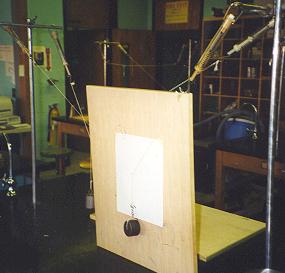Objectives: Determine the weight of an object by vector analysis.

Composition of Forces
Objectives: Determine the weight of an object by vector analysis.
Methods:
1. Sketch the set
up.
2. Tape your blank
paper on the board and place it behind the 3 strings with the
knot near the center.
3. Make two sharp points
on the paper directly behind each string such that a
straight line can be drawn later.
Accuracy is everything! Unless
the three lines meet in one place, repeat this step.
4. Record the force
(tension) in Newtons (N) of each spring balance.
Watch significant figures!
5. Determine the
mass of the object on the triple beam balance.
Analysis:
1. Remove the data
sheet and construct a vector diagram to show all three concurrent
vectors acting on the knot in the center.
Include the scale, arrows, angles, magnitudes,
etc.
2. Construct a
parallelogram of the two spring balance forces to determine
the resultant and equilibrant.
Label fully.
3. Verify the
magnitude of the resultant using the angle of the string from the
vertical (θ) and the equation Cosθ (Force) for each
string (see notes from class).
3. Determine the
angle of difference between the equilibrant and your data sheet.
What does this angle indicate?
4. Compare the
calculated Weight (the equilibrant on your paper) with the
actual Weight. Compute
a % error.
5. Define the terms resultant
and equilibrant.
Back to the Brockport High School Science Department